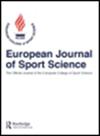超声心动图评估心肌效率可预测运动表现
IF 2.4
3区 医学
Q2 SPORT SCIENCES
引用次数: 0
摘要
心功能是心肺功能的主要决定因素。本研究旨在确定新的超声心动图心肌功能和静息时的效率参数能否预测不同类型的长时间高强度耐力运动中的运动表现。研究人员在运动前对 40 名 50.3 ± 9.1 岁的健康休闲运动员(75% 为男性)进行了超声心动图检查。将静息时的超声心动图参数与两种不同运动中通过功率输出评估的运动表现进行了比较:乳酸阈值和心肺运动测试(La-CPET)和 91 公里山地自行车赛。La-CPET 的中位持续时间为 43 (40, 45) 分钟,平均输出功率为 2.9 ± 0.5 W/kg。比赛的中位持续时间为 236(214,268)分钟,平均输出功率为 2.1 ± 0.5 W/kg。成绩最好的人左心室有中度扩张。心肌效率参数--总体浪费功(GWW)与比赛持续时间呈正相关(rho = 0.42,p = 0.008),与 La-CPET 和比赛期间的平均功率输出呈负相关(rho = -0.43,p = 0.007)(rho = -0.44,p = 0.005)。在包括左心室容积在内的多变量模型中,左侧 GWW 仍是比赛持续时间(β = 0.40,p = 0.007)、La-CPET 期间平均输出功率(β = -0.40,p = 0.006)和比赛(β = -0.43,p = 0.003)的独立预测因子。在静息状态下测量的新型超声心动图心肌效率参数 GWW 是健康中年运动员长时间高强度耐力运动表现的独立预测指标。这些研究结果表明,静息时的心肌效率参数可能有助于识别运动诱发的左心室扩张。本文章由计算机程序翻译,如有差异,请以英文原文为准。
Echocardiographic assessment of myocardial efficiency predicts exercise performance
Cardiac function is a major determinant of cardiopulmonary fitness. This study aimed to determine if novel echocardiographic myocardial function and efficiency parameters at rest can predict exercise performance during different types of prolonged high‐intensity endurance exercise. Echocardiography was performed before exercise in 40 healthy (75% males) 50.3 ± 9.1‐year‐old recreational athletes. Echocardiographic parameters at rest were compared with exercise performance assessed by power output during two different exercises: A lactate threshold and cardiopulmonary exercise test (La‐CPET) and a 91‐km mountain bike sport cycling race. The La‐CPET had a median duration of 43 (40, 45) minutes and a mean power output of 2.9 ± 0.5 W/kg. The race had a median duration of 236 (214, 268) minutes and a mean power output of 2.1 ± 0.5 W/kg. There was moderate left ventricular (LV) dilatation in individuals with the highest performance. The myocardial efficiency parameter, global wasted work (GWW), was positively correlated with race duration (rho = 0.42, p = 0.008) and negatively correlated with mean power output during both the La‐CPET (rho = −0.43, p = 0.007) and the race (rho = −0.44, p = 0.005). In multivariable models, including LV volumes, left GWW remained an independent predictor of race duration (beta = 0.40, p = 0.007) and of mean power output during the La‐CPET (beta = −0.40, p = 0.006) and the race (beta = −0.43, p = 0.003). The novel echocardiographic myocardial efficiency parameter, GWW, measured at rest, is an independent predictor of prolonged high‐intensity endurance exercise performance in healthy middle‐aged athletes. These findings suggest that resting myocardial efficiency parameters may aid the identification of exercise‐induced LV dilatation.
求助全文
通过发布文献求助,成功后即可免费获取论文全文。
去求助
来源期刊
CiteScore
6.60
自引率
3.10%
发文量
153
审稿时长
6-12 weeks
期刊介绍:
The European Journal of Sport Science (EJSS) is the official Medline- and Thomson Reuters-listed journal of the European College of Sport Science. The editorial policy of the Journal pursues the multi-disciplinary aims of the College: to promote the highest standards of scientific study and scholarship in respect of the following fields: (a) Applied Sport Sciences; (b) Biomechanics and Motor Control; c) Physiology and Nutrition; (d) Psychology, Social Sciences and Humanities and (e) Sports and Exercise Medicine and Health.

 求助内容:
求助内容: 应助结果提醒方式:
应助结果提醒方式:


